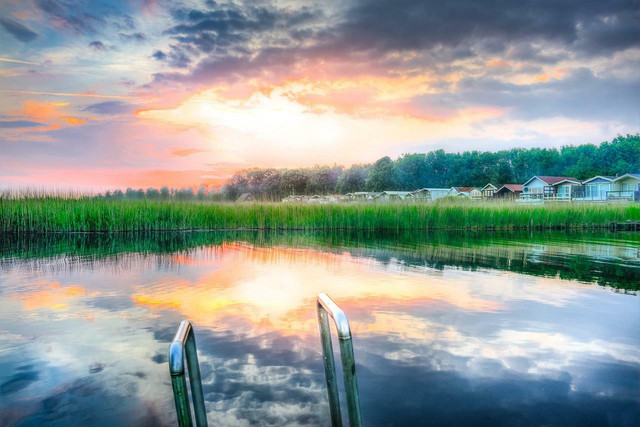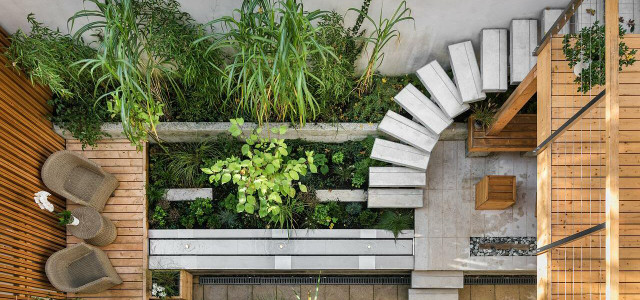Though popular in Europe, natural swimming ponds are still relatively unheard of in the U.S. So what is a natural swimming pond exactly? We will outline the basics.
Natural swimming ponds are sometimes designed to imitate ponds, pools and other naturally occurring bodies of water, often coming in irregular shapes, with the added features of waterfalls, plant life and rock formations.
When designed and installed properly, a natural swimming pool is normally far more environmentally friendly than conventional swimming pools: they use a natural filtration system that does not require the use of synthetic chemicals and power-guzzling filters and cleaning equipment. These natural swimming pools will also demand much less maintenance, and their yearly costs work out to be much less expensive in the long run.
How Does a Natural Swimming Pond Work?

(Foto: CC0 / Pixabay / rgerber)
Chemical free filtration
Unlike most chlorinated swimming pools, natural swimming pools are filtered organically. This basically means that a second, smaller pool called a ‘regeneration zone’ is built adjacent to your swimming pond. In this regeneration zone, water runs through either a natural gravel filter or, alternatively, a constructed ‘wetlands’ made of aquatic plants that filter the water through their natural processes.
Surprisingly, this natural filter system works just as well as a chemically-filtered system, with the bonus of being more environmentally friendly. Your natural pool and the regeneration zone work in tandem to create a small ecosystem that evolves over time, with local wildlife being attracted to the regeneration zone. Because of this, pesky insects won’t invade your natural pond, since it is only the regeneration zone that offers them the environment they are looking for.
Natural swimming pond planning
Municipal regulations will vary depending on where you live and just like a normal swimming pool, you will need to strictly adhere to the correct processes to ensure your natural swimming pool will not pose any potential safety hazard for you, your family or your neighbors. Before starting your project, you will need to familiarize yourself with any legal responsibilities to ensure your efforts are a complete success.
How long will it take to install one?
Depending on the size and shape of your chosen natural swimming pond design, and what extra features (if any) you have decided to add, it commonly takes anywhere between six and twelve weeks to properly install and natural swimming pond.
The Benefits of a Natural Swimming Pond



(Foto: CC0 / Pixabay / Skitterphoto)
Depending on who you talk to, installing and then maintaining a natural swimming pool will cost you less, or more, than a regular swimming pool. With any project of this scale, design, complexity and additional features will be the biggest players in determining the over all cost of a natural swimming pool.
One huge advantage that natural pools have over chlorinated pools, is that no further landscaping is required as would be the case with a traditional pool. Since your natural pool will not require an ongoing cost for chlorine and other chemicals, you will save a lot on these added costs long-term.
Most professionals offering natural swimming pool installations commonly suggest that you should plan on spending anywhere between $7,000 to $20,000 from planning through to completion of your natural pool. Alternatively, if you fancy yourself a bit of handyman, a natural swimming pool can be constructed for as little as $2,000.
Of course, these prices are very much general estimates, and consulting with the appropriate experts will give you a much clearer idea of the real cost. In short, you will need to do your homework to make sure that the budget is a good fit for your needs.
Natural swimming pools are made using stone, gravel and even clay instead of concrete or fiberglass, so the material also comes from nature. Natural pools are also very adaptable, opening up a range of exciting design possibilities that most traditional pools can’t provide.
Organic pools will demand much less of your time when it comes to maintenance, as the regeneration zone virtually does everything for you — you just have to make sure you keep debris out of the pool water. You won’t have to worry about the constant need for chlorine, chemical filtration, pH balancing and other weekly chores that go into keeping a normal pool clean and safe for use.
Tip: 5 Great Reasons to Try Wild Swimming
Pros of a natural pond
- Lower ongoing costs
- Adaptable and imaginative design ideas
- Less maintenance
- Will function effectively in any type of climate
- Organic and environmentally-friendly
The Downsides of a Natural Swimming Pond



(Foto: CC0 / Pixabay / Didgeman)
Building a natural pool can get quite expensive, simply because it needs that entirely separate pool nearby for filtration. The regeneration zone also means that you require more space in which to build your natural pool, which might become tricky if your backyard is on the smaller side.
The aesthetics of a natural swimming pool can also dissuade many potential buyers, since the organic water comes with a murkier looking color that is in stark contrast to the typical crystal clear, chemically treated swimming pool with blue tiles. Though the water in a natural pool is perfectly safe to swim in, your natural pool may not look as nice as your neighbor’s conventional swimming pool.
To have the pool built, you need to find an experienced contractor who is familiar with building organic pools and ponds. You might also want to find professional support to make you help design decisions to make sure the natural pool looks just as good in real life as you imagine it.
Cons of all natural swimming pools
- Higher initial costs to install
- The regeneration zone means using more space
- Water in natural pools may look brownish rather than bright blue
- A skilled contractor specializing in natural swimming ponds may be difficult to find
Read more:
- Cold Water Swimming: Why You Should Try It
- Native Gardening for Wildlife: Benefits and Tips for Beginners
- Wild Swimming: 5 Great Reasons to Try It
Do you like this post?







